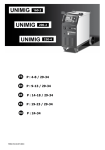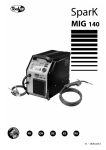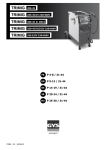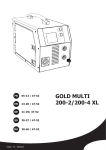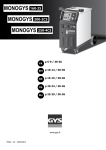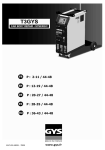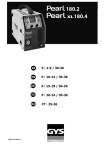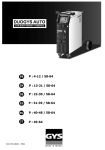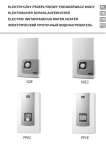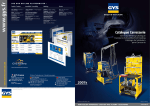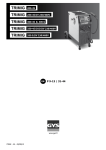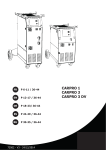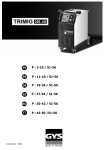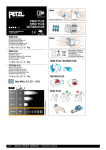Download S152-Trimig 385-4S_FR-EN-DE-ES-RU_75540
Transcript
P : 2- 9/ 43-48 P : 10-17 / 43-48 P : 18-25 / 42-48 P : 26-33 / 43-48 P : 34-48 200710–S152- 75540 www.gys.fr MONTAGE DESCRIPTION ⑩ ⑬ ⑥ ⑫ ⑤ ⑦ ⑫ ② ③ ④ ① ⑧ ⑨ 100 kg ⑮ Gaine acier Tube capillaire ⑯ Tube capillaire Gaine téflon 2 DESCRIPTION Merci de votre choix ! Afin de tirer le maximum de satisfaction de votre poste, veuillez lire avec attention ce qui suit : Le Trimig 385-4 S est un poste de soudure semi-automatique « synergic » sur roues, ventilé pour le soudage (MIG ou MAG). Il est recommandé pour le soudage des aciers, des inox, des aluminums. Son réglage est simple et rapide grâce à sa fonction « vitesse de fil synergique ». Il fonctionne sur une alimentation 400V triphasée. ALIMENTATION ELECTRIQUE Le courant effectif absorbé (I1eff) pour les conditions d'utilisation maximales est indiqué sur l'appareil. Vérifier que l'alimentation et ses protections (fusible et/ou disjoncteur) sont compatibles avec le courant nécessaire en utilisation. L'appareil doit être placé de façon telle que la fiche de prise de courant soit accessible. Ne pas utiliser de rallonge ayant une section inférieure à 4 mm². Le TRIMIG 385-4S est livré avec une prise 32A de type CEE 7/7. Il doit être relié à une prise 400V 3Ph. AVEC terre protégée par un disjoncteur 32A et un différentiel 30mA. DESCRIPTION DU POSTE ① Interrupteur marche – arrêt ⑥ Support torches avant ② Réglage de puissance par 2 commutateurs (2 et 7 positions) permet d’ajuster la tension de soudage en sortie de générateur. Le réglage de tension de sortie est proportionnel à l’épaisseur du matériau à souder. (cf page 6) ⑦ Câble d’alimentation (5m) ③ Clavier de réglages des paramètres de soudage (mode manuel ou automatique). ⑩ Chaine de fixation pour bouteilles. ④ Raccords torche au standard européen. ⑪ Support bobine Ø 200/300 mm. ⑤ Voyant de protection thermique sur le clavier de commande : signale une coupure thermique lorsque l’appareil est utilisé de façon intensive (coupure de plusieurs minutes). ⑫ Electrovanne torche. ⑧ Sortie pince de masse. ⑨ Support bouteilles (maxi une bouteille de 10m3). Attention : bien fixer les bouteilles ⑬ Support cables arrière. SOUDAGE SEMI-AUTOMATIQUE EN ACIER / INOX (MODE MAG) Le Trimig 385-4S peut souder du fil acier et inox de 0,8/1/1,2. (figure ⑮) L’appareil est livré d’origine pour fonctionner avec du fil Ø 1 mm en acier( galets Ø 0,8/1) Lorsque vous utilisez du fil de diamètre 1 mm ; il convient d’utiliser une torche avec un tube contact de 1. Le galet du moto-dévidoir est un galet réversible 0,8 / 1mm. Dans ce cas, le positionner de telle façon à lire 1 mm sur le flanc visible du galet. L’utilisation en acier ou inox nécessite un gaz spécifique au soudage argon + CO2 (Ar + CO2 ).La proportion de CO2 varie selon l’utilisation. Pour le choix du gaz, demander conseil à un distributeur de gaz. Le débit de gaz en acier se situe entre 8 et 12 L/min selon l’environnement et l’expérience du soudeur. SOUDAGE SEMI-AUTOMATIQUE ALUMINIUM Le Trimig 385-4S peut souder du fil aluminium de 1 mm et 1,2 mm. (figure ⑯) Pour souder l’aluminium, il faut utiliser un gaz neutre: argon pur (Ar). Pour le choix du gaz, demander conseil à un distributeur de gaz. Le débit du gaz se situe entre 15 et 25 L/min selon l’environnement et l’expérience du soudeur. Ci-dessous les différences entre l’utilisation soudage acier et soudage aluminium : - La pression des galets presseurs du moto-dévidoir sur le fil : mettre un minimum de pression afin de ne pas écraser le fil. - Tube capillaire : retirer le tube capillaire avant de connecter la torche aluminium avec une gaine en téflon. - Torche : utiliser une torche spéciale alumimium. Cette torche possède une gaine téflon afin de réduire les frottements. - NE PAS couper la Gaine au bord du raccord ! cette gaine sert à guider le fil à partir des galets. (cf schéma ⑯) Tube contact : utiliser un tube contact SPECIAL aluminium correspondant au diamètre du fil. 3 PROCEDURE DE MONTAGE DES BOBINES : ① ③ ② ④ ⑧ ⑦ ⑥ ⑤ ⑨ CLAVIER DE COMMANDE : ⑬ ⑪ ⑩ ⑫ ⑭ 4 PROCEDURE DE MONTAGE DES BOBINES ET DES TORCHES : • Ouvrir la trappe du poste. • Positionner la bobine en tenant compte de l’ergot d’entrainement ③ du support bobine. • Régler le frein de la bobine ④ pour éviter lors de l’arrêt de la soudure que l’inertie de la bobine n’emmêle le fil. De manière générale, ne pas serrer trop fort ! • Les galets moteur ⑨ sont des galets double gorge (Ø 0,8/ Ø 1 ou Ø 1/ Ø 1,2). L’indication qu’on lit sur le galet est celle que l’on utilise. Pour un fil de Ø 1 mm, utiliser la gorge de Ø 1. • Pour la première mise en service : o désserrer la vis de fixation du guide fil ⑧ o placer les galets o puis positionner le guide fil ⑦ au plus près du galet mais sans contact avec ce dernier, puis resserrer la vis de fixation. • Pour régler la molette des galets presseurs ⑥ , procéder comme suit : desserrer au maximum, actionner le moteur en appuyant sur la gâchette de la torche, serrer la molette tout en restant appuyé sur la gâchette. Plier le fil en sortie de la buse. Mettre un doigt sur le fil plié pour l’empécher d’avancer. Le réglage du serrage est bon lorsque les galets patinent sur le fil même si le fil est bloqué en bout de troche. Réglage courant de la molette des galets ⑥ : graduation sur 3 pour l’acier et graduation sur 2 pour l’aluminium. RACCORDEMENT GAZ Visser le mano-détendeur sur la bouteille de gaz. ① Pour éviter toute fuite de gaz, utiliser les colliers fournis dans la boîte d’accessoires. CHOIX DES BOBINES: Configurations possibles : Type fil Acier INOX Alu AG5 Ø Ø Ø Ø Ø Torche 300 200 200 300 200 X X X X* X* GAZ Argon + CO2 Argon pur CLAVIER DE COMMANDE : Choix du mode de soudage ⑩ 2T : soudage 2 temps 4T : soudage 4 temps SPOT : fonction bouchonnage /spot, Avec réglage du diamètre du point Réglage de la vitesse fil ⑪ Potentiomètre d’ajustage de la vitesse du fil. La vitesse varie de 1 à 22 m/minute. *Prévoir gaine téflon. et tube contact spécial alu Mode Manual ⑬ En mode manuel, la v itesse de dévidage du fil est déterminée par l’utilisateur en ajustant le potentiomètre ⑪. Mode Synergic ⑭ Positionner le potentiomètre ⑪ au milieu de la zone « OPTIMAL SYNERGIC » Dans ce mode le poste détermine la vitesse de fil Potentiomètre de réglage SPOT ⑫ optimale à partir de 3 paramètres : Tension Diamètre du fil Nature du fil Il est possible d’ajuster la vitesse du fil + / -. En position 2T et 4T, 2 modes sont proposés pour faciliter le réglage du poste : MANUAL ou SYNERGIC. 5 MODE « SYNERGIC » : 6 MODE «MANUAL » Pour régler votre poste procéder comme suit : - Choisissez la tension de soudage à l’aide des 2 commutateurs 2/7 positions exemple : Pour souder de l’acier 1 mm - commutateur du haut sur A - commutateur du bas sur 1 Pour souder de l’acier 10 mm - commutateur haut sur B - commutateur bas sur 7 - Ajustez la vitesse du fil à l’aide du potentiomètre. Conseils L’ajustement de la vitesse du fil se fait souvent « au bruit » : l’arc doit être stable et avoir très peu de crépitement. Si la vitesse est trop faible, l’arc n’est pas continu. Si la vitesse est trop élevée, l’arc crépite et le fil a tendance à repousser la torche. MODE « SYNERGIC » Grâce à cette fonction, plus besoin de régler la vitesse fil. - Positionner le potentiomètre vitesse fil au milieu de la zone « Optimal synergic » Sélectionner : La nature du fil le diamètre du fil La puissance (2 commutateurs 2 et 7 positions en face avant) Pour sélectionner la position adéquate en fonction de l’épaisseur à souder se référer au tableau « mode synergic » de la page en vis à vis. A partir de cette combinaison de paramètres, le Trimig 385-4 S détermine la vitesse de fil optimale et le poste est pret à souder.Il est ensuite possible d’ajuster la vitesse fil si nécessaire en + ou en – grâce au potentiomètre. Une mémorisation des dernières configurations de soudage est effectuée et réactivée à chaque mise en route du poste (diamètre fil, nature fil, mode). CONSEILS ET PROTECTION THERMIQUE • Le trimig 385-4S ne doit pas être élingué par ses poignées, ses supports torches ou son plateau supérieur mais par le dessous du poste. • Respecter les règles classiques du soudage. • Laisser les ouïes de l'appareil libres pour l’entrée et la sortie d’air. • Laisser l’appareil branché après soudage pour permettre le refroidissement. • Protection thermique : le voyant s’allume et la durée de refroidissement est de quelques minutes en fonction de la température ambiante. FACTEURS DE MARCHE & ENVIRONNEMENT D’UTILSATION • Le poste décrit a une caractéristique de sortie de type "tension constante". Son facteur de marche selon la norme EN60974-1 est indiqué dans le tableau suivant : X / 60974-1 @ 40°C (T cycle = 10 min) I max 60% (T cycle = 10 min) 100% (T cycle = 10 min) Trimig 385-45 S 25% @ 370 A 280 A 210 A Note : les essais d’échauffement ont été effectués à température ambiante et le facteur de marche à 40 °C a été déterminé par simulation. • Ces appareils sont de Classe A. Ils sont conçus pour un emploi dans un environnement industriel ou professionnel. Dans un environnement différent, il peut être difficile d’assurer la compatibilité électromagnétique, à cause de perturbations conduites aussi bien que rayonnées. Ne pas utiliser dans un env ironnement comportant des poussières métalliques conductrices. 7 ENTRETIEN • L'entretien ne doit être effectué que par une personne qualifiée. • Couper l'alimentation en débranchant la prise, et attendre l’arrêt du ventilateur avant de travailler sur l'appareil. A l’intérieur, les tensions et intensités sont élevées et dangereuses. • Régulièrement, enlever le capot et dépoussiérer à la soufflette. En profiter pour faire vérifier la tenue des connexions électriques avec un outil isolé par un personnel qualifié. • Contrôler régulièrement l'état du cordon d'alimentation. Si le câble d'alimentation est endommagé, il doit être remplacé par le fabricant, son service après vente ou une personne de qualification similaire, afin d'éviter un danger SÉCURITÉ Le soudage MIG/MAG peut être dangereux et causer des blessures graves voire mortelles. Protégezvous et protégez les autres. Respectez les instructions de sécurité suivantes: Rayonnements de l’arc : Pluie, vapeur d’eau, humidité: Choc électrique : Chutes : Brûlures : Risques de feu : Fumées : Précautions supplémentaires : Vous protéger à l’aide d’un masque muni de filtres conformes EN 169 ou EN 379. Utiliser votre poste dans une atmosphère propre (degré de pollution ≤ 3), à plat et à plus d’un mètre de la pièce à souder. Ne pas utiliser sous la pluie ou la neige. Cet appareil ne doit être utilisé que sur une alimentation monophasée à 3 fils avec terre. Ne pas toucher les pièces sous tension. Vérifier que le réseau d'alimentation est adapté au poste. Ne pas faire transiter le poste au-dessus de personnes ou d’objets. Porter des vêtements de travail en tissu ignifugé (coton, bleu ou jeans). Travailler avec des gants de protection et un tablier ignifugé. Protéger les autres en installant des paravents ininflammables, ou les prévenir de ne pas regarder l'arc et garder des distances suffisantes. Supprimer tous les produits inflammables de l'espace de travail. Ne pas travailler en présence de gaz inflammable. Ne pas inhaler les gaz et fumées de soudage. Utiliser dans un environnement correctement ventilé, avec extraction artificielle si soudage en intérieur. Toute opération de soudage : - dans des lieux comportant des risques accrus de choc électrique, - dans des lieux fermés, - en présence de matériau inflammable ou comportant des risques d'explosion, doit toujours être soumise à l'approbation préalable d'un "responsable expert", et effectuée en présence de personnes formées pour intervenir en cas d'urgence. Les moyens techniques de protections décrits dans la Spécification Technique CEI/IEC 62081 doivent être appliqués. Le soudage en position surélevée est interdit, sauf en cas d'utilisation de plates-formes de sécurité. Les porteurs de stimulateurs cardiaques doivent consulter un médecin avant d'utiliser ces appareils. Ne pas utiliser le poste pour dégeler des canalisations. Manipuler la bouteille de gaz avec précaution, des risques existent si la bouteille ou la soupape de la bouteille sont endommagées. 8 ANOMALIES, CAUSES, REMÈDES SYMPTOMES Le débit du fil de soudage n’est pas constant. Le moteur de dévidage ne fonctionne pas. CAUSES POSSIBLES Des grattons obstruent l’orifice. REMEDES Nettoyer le tube contact ou le changer et remettre du produit anti-adhésion. Le fil patine dans les galets. - Contrôler la pression des galets ou les remplacer. - Diamètre du fil non conforme au galet. -Gaine guide fil dans la torche non conforme. Desserrer le frein et les galets Frein de la bobine ou galet trop serré. Problème d’alimentation Vérifier que le bouton de mise en service est sur la position marche. Nettoyer ou remplacer. Mauvais dévidage du fil. Gaine guide fil sale ou endommagée. Frein de la bobine trop serré. Pas de courant de soudage. Mauvais branchement de la prise secteur. Voir le branchement de la prise et regarder si la prise est bien alimentée avec 3 phases. Mauvaise connexion de masse. Contrôler le câble de masse (connexion et état de la pince). Contrôler la gâchette de la torche. Le fil bouchonne après les galets. Le cordon de soudage est poreux. Contacteur de puissance inopérant. Gaine guide fil écrasée. Desserrer le frein. Vérifier la gaine et corps de torche. Blocage du fil dans la torche. Remplacer ou nettoyer. Pas de tube capillaire. Vitesse du fil trop importante. Le débit de gaz est insuffisant. Vérifier la présence du tube capillaire. Réduire la vitesse de fil Plage de réglage de 15 à 20 L / min. Nettoyer le métal de base. La remplacer. Bouteille de gaz vide. Qualité du gaz non satisfaisante. Le remplacer. Circulation d’air ou influence du vent. Buse gaz trop encrassée. Empêcher les courants d’air, protéger la zone de soudage. Nettoyer la buse gaz ou la remplacer. Mauvaise qualité du fil. Utiliser un fil adapté au soudage MIGMAG. Nettoyer la pièce avant de souder État de la surface à souder de mauvaise qualité (rouille, etc…) Particules d’étincelage très importantes. Tension d’arc trop basse ou trop haute. Voir paramètres de soudage. Mauvaise prise de masse. Contrôler et positionner la pince de masse au plus proche de la zone à souder Ajuster le débit de gaz. Gaz de protection insuffisant. Pas de gaz en sortie de torche Mauvaise connexion du gaz Voir si le raccordement du gaz à côté du moteur est bien connecté. 9 ASSEMBLY DESCRIPTION ⑩ ⑬ ⑥ ⑫ ⑤ ⑦ ⑫ ② ③ ④ ① ⑧ ⑨ 100 kg ⑮ Steel sheathing Capillar ⑯ Capillar Teflon sheathing 10 DESCRIPTION The Trimig 385-4 S is a semi-automatic welding unit; it is ventilated for semi-automatic welding (MIG or MAG) It is capable of welding steel, stainless steel and aluminium, and with it's « synergic wire speed » function adjustment is easy and fast. It works on a 400v Three-phase power supply. ELECTRICITY SUPPLY The absorbed current (I1eff) is indicated on the device, for use at maximum settings. Check that the power supply and its protection (fuse and/or circuit breaker) are compatible with the current needed during use. The device must be placed in such way that the power socket is always accessible. Do not use an extension cord which has a wire section inferior to 4 mm². The Trimig 385-4 S is supplied with a 32A plug type EEC7/7. It should be plugged in to a 400 V (3PH) power socket WITH earth and protected by a circuit breaker (32A and 1 differential 30mA. ) DEVICE PRESENTATION Switch On – Off Power Settings - 2 switches with 7 positions : allows ⑥ Torch support. ⑦ Supply Cable (5m). adjustment of the welding voltage output. The adjustment of the output voltage is proportional to the thickness of the material to weld. (please refer to page 14) ⑧ Out Earth cable. ⑨ Gas bottle support (max 1 bottle of 10m3). Welding settings adjustment keyboard (manual or ⑩ Fastening chain for bottles. Warning: fasten the automatic mode). bottles correctly. European standard torch connection. ⑪ Reel support Ø 300 mm/ 200mm. ⑤Thermal Protection light: ⑫ Solenoid valve torch. Informs when a short Cool-down period is necessary following intensive use. ⑬ Torch Cable support . SEMI-AUTOMATIC WELDING FOR STEEL / STAINLESS STEEL (MAG MODE) The TRIMIG 385-4S can weld 0.8/1/1,2 mm steel and stainless steel wires .(figure ⑮) The device is capable of working with Ø 1 mm steel wire (roller Ø 0.8/1.0) If using Ø 1mm wire, you should use a torch with a contact tip of 1, and ensure that the reversible rollers in the wire feeder are posititioned correctly (so that the writing that states “1mm” is visible when in place) For Steel or Stainless Steel, you will need to use specific gas - Argon + CO2 (Ar + CO2). The proportion of CO2 will vary depending on usage. The gas flow for steel is between 8 and 12L / min depending on the environment and experience of the welder. For the specific requirements, seek advice from your gas distributor. SEMI-AUTOMATIC WELDING FOR ALUMINIUM (MIG MODE) The TRIMIG 385-4S can weld 1mm & 1,2 mm aluminium wire ⑯ To weld aluminium, neutral gas “pure Argon” (AR) is required. When choosing gas, ask a gas distributor for advice. The gas flow in aluminium should be between 15 and 25 L / min depending on the environment and experience of the welder. Things to note when welding with Aluminium - Set the pressure rollers of the wire feeder on the wire to minimum pressure so as not to pinch the wire - Remove the capillary tube before connecting the aluminium torch - When welding aluminium use a special aluminium torch with Teflon sheath to reduce friction. Do not cut the sheath near the connector! It is used to guide the wire from the rollers. (See diagram ⑯) - Contact Tip: Use the specific Aluminium contact tip corresponding to the diameter of the wire. 11 PROCESS OF REELS ASSEMBLY : ① ② ③ ④ ⑧ ⑦ ⑥ ⑤ ⑨ SETTINGS KEYBOARD: ⑬ ⑪ ⑩ ⑫ ⑭ 12 PROCESS OF REELS AND TORCHES ASSEMBLY • Open the door on the product. • Place the reel on the driving pin of the reel support • Tighten the nut until the reel is secure to avoid the reel inertia tangling the wire when the welding stops. In a general way, do not over-tighten. • The wire feeder is a double groove rollers (Ø Ø 0,8/1 or Ø 1/ Ø1,2). The visible diameter indicated on the roller when fitted is the diameter currently in use. For a Ø 1 wire, use the Ø 1 groove. • For the first use: - Release the fixing screw of the wire guide - Place the rollers - Then place the wire guide as close as possible to the roller but without touching it, then tighten the fixing screw. • To set the adjusting knob of the pressing rollers ,proceed as follow: : loosen the knob fully, start the motor by pressing the torch trigger, tighten the adjustment knob whilst pressing the trigger. Bend the wire where it comes out of the nozzle and hold it in place to stop its progress. The setting is correct when the guide roller slides over the wire even when it is blocked at the end of the torch. A common adjustment is the rollers command on the scale 3 for steel and 2 for aluminum. GAS COUPLING Screw the regulator/flowmeter on the gas bottle. ⑬ To avoid gas leaks, use the collars provided in the accessories box. CHOICE OF REELS: Possible settings: Wire Steel Stainless Steel Alu AG5 Torch Ø 300 Ø 200 X X Ø 200 X Ø 300 X* Ø 200 X* GAS Argon + CO2 Pur Argon SETTINGS KEYBOARD: Welding mode choice 2T : two-stage welding 4T: 4-stage welding SPOT : Spot welding with adjustable spot diameter Manual Mode ⑬ In manual mode, the wire speed is determinated by Wire speed settings ⑪ Wire speed fitting potentiometer. The speed varies from 1 to 22 m/minute. Position the potentiometer ⑪ in the middle of the« OPTIMAL SYNERGIC » zone In this mode, the device determines the optimal wire speed according to 3 parameters: Voltage Wire diameter The power mode It is possbile to adjust the speed wire + / -. SPOT potentiometer fitting ⑫ the user by adjusting the potentiometer⑪. Synergic Mode ⑭ In 2T or 4T position, 2 modes are proposed to ease the settings of the device: MANUAL or SYNERGIC. 13 MODE « SYNERGIC » : 14 «MANUAL» MODE To set your device, proceed as follows: - Choose the welding voltage using the 2 power switches (2& 7 positions) Example: For welding Steel - 1 mm - Set the top switch to "A" - Set the bottom switch to "1" For welding Steel - 10 mm - Set the top switch to "B" - Set the bottom switch to "7" - Adjust the wire speed with the potentiometer. Advice The wire speed adjustment is often determined « by the noise »: the arc must be stable and have a low crackling. If the speed is too low, the arc is not continuous. If the speed is too high, the arc crackles and the wire pushes back the torch. « SYNERGIC » MODE This function automatically controls the wire speed. There is no need to set the wire speed manually. Position the wire speed potentiometer in the middle of the« Optimal synergic » zone. - Select: Wire type Wire diameter Power mode (2 switches, 2 & 7 positions) To select the right position in accordance with the thickness of the part to weld, please refer to the “synergic mode” table on the previous page. From the settings chosen, the Trimig 385-4S determines the optimum wire speed and the device is ready to weld. It is also possible to adjust the wire speed if necessary by adjusting potentiometer + or – manually . The last welding configuration is saved in the memory automatically (wire diameter, wire type, mode). ADVICE & THERMAL PROTECTION • The Trimig 385-4S should not be lifted by its handles, torch support, or the top of the machine. When lifting the Trimig, ensure the weight is fully supported at the bottom of the machine. • Always respect the basic rules of welding. • Do not block/cover the ventilation holes of the machine. • Leave the device plugged after welding to allow it to cool. • Thermal protection: If the machine becomes too hot, the warning light will illuminate and the machine will stop. Cooling will take a few minutes, the length of time will also depend on the external temperature. DUTY CYCLE & WELDING ENVIRONMENT IN USE • The welding unit describes an output characteristic of "constant current" type. The duty cycles following the standard EN60974-1 (at 40°C on a 10mn cycle) are indicated in the table here below: X / 60974-1 @ 40°C (T cycle = 10 min) I max Trimig 385-4S 25% @ 370 A 60% (T cycle = 10 min) 280 A 100% (T cycle = 10 min) 210 A Note : The machines’ duty cycle has been tested at room temperature (40°C) and has been determined by simulation. • These are Class-A devices. They are designed to be used in an industrial or professional environment. In a different environment, it can be difficult to ensure electromagnetic compatibility, due to conducted disturbances as well as radiation. 15 MAINTENANCE / ADVICE Maintenance should only be carried out by a qualified person. Ensure the machine is unplugged, and that the ventilator inside has stopped before carrying out maintenance work. (DANGER High Voltage and Currents). GYS recommends removing the steel cover 2 or 3 times a year to remove any excess dust. Take this opportunity to have the electrical connections checked by a qualified person with an insulated tool. Regularly check the condition of the power supply cord. If damaged, it will need to be replaced by the manufacturer, its’ after sales service or a qualified person. Ensure the ventilation holes of the device are not blocked to allow adequate air circulation. SAFETY Arc welding can be dangerous and can cause serious and even fatal injuries. Protect yourself and others. Ensure the following safety precautions are taken: Arc radiation Rain, steam, damp Electric shock Falls Burns Protect yourself with a helmet fitted with filters in compliance with EN169 or EN 379. Use your welding unit in a clean/dry environment (pollution factor ≤ 3), on a flat surface, and more than one meter from the welding work-piece. Do not use in rain or snow. This device must only be used with an earthed power supply. Do not touch the parts under tension. Check that the power supply is suitable for this unit. Do not move the unit over people or objects. Wear protective (fire-proof) clothing (cotton, overalls or jeans). Wear protective gloves and a fire-proof apron. Ensure other people keep a safe distance from the work area and do not look directly at the welding arc. Protect others by installing fire-proof protection walls. Fire risks Fumes Additional Precautions Remove all flammable products from the work area. Do not work in presence of flammable gases. Do not inhale welding gases and fumes. Use the device in a well ventilated environment, with artificial extraction if welding indoors. Any welding operation undertaken in..... - rooms where there is an increased risk of electric shocks, - Poorly ventilated rooms, - In the presence of flammable or explosive material, ......should always be approved by a "responsible expert", and made in presence of people trained to intervene in case of emergency. Technical protection as described in the Technical Specification CEI/IEC 62081 must be implemented. Welding in raised positions is forbidden, except in case of safety platforms use. People wearing Pacemakers are advised to see their doctor before using this device. Do not use the welding unit to unfreeze pipes. Handle gas bottles with care - there is increased danger if the bottle or its valve are damaged. 16 TROUBLESHOOTING SYMPTOMS The welding wire speed is not constant. POSSIBLE CAUSES Debris is blocking up the opening. The wire skids in the rollers. The wire-feeder motor doesn’t operate. Reel or roller brake too tight. Electrical supply problem. REMEDIES Clean out the contact batch or change it and replace the anti-adherence product. Ref.041806 - Control the roller pressure or replace it. - Wire diameter non-compatible with roller - Covering wire guide in the torch noncompatible. Release the brake and rollers. Check that the power switch is in the "On" position. Clean or replace Bad wire feeding. Covering wire guide dirty or damaged. Reel brake too tight No welding current Bad connection to the main supply. Check the mains connection and look if the plug is fed by 400 V (3PH) power socket. Bad earth connection. Torch trigger inoperative. Check the earth cable (connection and clamp condition). Check the torch trigger / replace torch Guide wire sheath crushed. Check the sheath and torch body. The wire jams (after the rollers) The welding bead is porous Very important flashing particules. Wire jammed in the torch Clean or replace. No capillary tube. Wire speed too fast The gas flow rate is not sufficient. Gas bottle empty. Check the presence of capillary tube. Reduce the wire speed Adjust flow range 15 to 20 L / min. Clean the working metal. Replace it. Gas quality unsatisfactory. Air flow or wind influence. Replace it. Prevent drafts, protect welding area. Gas nozzle dirty. Clean or replace the gas nozzle. Poor quality wire. Use suitable WIRE for MIG-MAG welding. Surface to weld in bad condtion. (rust, etc…) Arc voltage too low or too high. Clean the metal before welding. Bad earth connection. Adjust the earth cable for a better connection. Adjust the gas flow. Insufficient gas flow. No gas flow at the end of the torch. Release the brake Bad gas connection. See welding settings. Check the gas connection at the welding machine. Check the flowmeter and the solenoid valves. 17 MONTAGE BESCHREIBUNG ⑩ ⑬ ⑥ ⑫ ⑤ ⑦ ⑫ ② ③ ④ ① ⑧ ⑨ 100 kg ⑮ Stahlseele Kapillarrohr ⑯ Kapillarrohr Teflonseele 18 BESCHREIBUNG Wir freuen uns, dass Sie sich für ein Markengerät der Firma GYS entschieden haben und danken Ihnen für das entgegengebrachte Vertrauen. Bitte lesen Sie sorgfältig vor dem Erstgebrauch diese Betriebsanleitung. Die Trimig 385-4S ist ein synergisches Schutzgasschweißgerät, konzipiert um Schweißarbeiten an Stahl-, Edelstahl-, Alu-Dünn- und Karosserieblechen durchzuführen. Aufgrund der Funktion „synergische Drahtvorschubgeschwindigkeit“ ist die Handhabung dieses Gerätes schnell und einfach. Netzanschluss: 400V dreiphasig. NETZANSCHLUSS Für den Einsatz des Gerätes bei Maximaleinstellungen, ist der aufgenommene Strom (I1eff) am Gerät aufgedruckt. Überprüfen Sie, ob die Stromversorgung und die Schutzeinrichtungen (Sicherungen und/oder Schutzschalter) mit dem Strom, den Sie beim Schweißen benötigen, übereinstimmen. Achten Sie beim Aufstellen des Gerätes darauf, dass der Netzstecker immer frei zugänglich ist. Benutzen Sie kein Verlängerungskabel, dessen Querschnitt kleiner als 4mm² ist. Die Trimig 385-4S wird mit einem 32A Netzstecker (Typ RS-015 CEE 400V) geliefert und muss an eine dreiphasige 400V Steckdose + Erde (abgesichert durch 32A Kurve D oder Sicherung 30A Typ mA) angeschlossen werden. BESCHREIBUNG 1 Ein/ Aus Schalter 8 (-) Texasbuchse 2 Grob- und Feinstufenregler (2 und 7 Stufen) zur ⑨ Auflageplatte für Gasflasche (max. Anpassung der Schweißleistung adäquat zur zu 1 x 10m³ Gasflasche) verschweißenden Blechstärke (für weitere ⑩ Sicherungskette für Gasflaschen. Informationen: s. Seite 22) Achtung : Gasflaschen stets gegen 3 Bedienfeld zur Einstellung der Schweißparameter Rutschen und Kippen sichern! (Modus Manuell oder Automatisch) 4 Eurozentralanschluss zum Anschluss der ⑪ Aufnahmedorn für Drahtrolle Ø 200mm Schweißbrenner oder 300mm. 5 Kontrollampe für Thermoüberwachung: ⑫ Schutzgasanschluss (Magnetventil) Meldet Überlastung bei Überschreiten der maximalen Einschaltdauer ⑬ Hinterer Brennerhalter 6 Vorderer Brennerhalter 7 Netzsstromkabel (5m) SYNERGISCHES STAHL-/ EDELSTAHL- SCHWEISSEN (MAG MODUS) Mit der Trimig 385-4S können 0.8/1.0 und 1.2mm Stahl- und Edelstahl-Drähte verschweißt werden (s. Abbildung ⑮). Das Gerät ist für den Betrieb mit Ø 1mm Stahldraht werksseitig voreingestellt (Drahtrolle Ø 0.8/1.0mm). Bei Draht Ø 1mm, ist ein Brenner mit einem Ø 1mm Kontaktrohr erforderlich. Die Drahtförderrollen weisen je zwei verschiedene Drahtaufnahmenuten auf (z.B. Ø 0.8/1.0mm). Die zu wählende Nutenbreite ist seitlich auf der Rolle gekennzeichnet. Stahl- und Edelstahl-Schweißungen können die Verwendung spezifischer Mischgase z.B. Argon + CO2 (Ar + CO2). erfordern. Der Mengenanteil des CO2 variiert je nach Einsatzzweck. Empfehlung: Fragen Sie den Gasfachhandel nach dem optimalen Gas bei außergewöhlichen Anwendungen. Die Gasdurchflussmenge bei Stahlschweißarbeiten beträgt in der Regel 8 bis 12 L/min je nach Umgebungsverhältnissen und indivduellen Bedürfnissen des Schweißers. SYNERGISCHES ALUMINIUM - SCHWEISSEN (MIG MODUS) Mit der Trimig 385-4S können 1.0 und 1.2mm Ø Aluminiumdrähte verschweißt werden (s. Abbildung ⑯). Um Aluminium zu schweißen, ist das neutrale Gas “Rein-Argon” (AR) zu empfehlen. Empfehlung: Fragen Sie den Gasfachhandel nach dem optimalen Gas bei außergewöhlichen Anwendungen. Die Gasdurchflussmenge bei Aluminiumschweißarbeiten beträgt in der Regel 15 bis 25 L/min je nach Umgebungsverhältnissen und indivduellen Bedürfnissen des Schweißers. Unterscheidung bei der Einrichtung der Maschine mit Stahl- oder Aluminiumdrähten: - Der weiche Aluminiumdraht sollte mit möglichst geringem Anpressdruck zwischen den Drahtförderrollen transportiert werden, da er andernfalls deformiert und ungleichmäßig gefördert wird. - Kapillarrohr: Bei dem Einsatz eines speziellen Aluminiumbrenners sollte das im Zentralanschluss steckende Rohr entfernt werden. Stattdessen wird hier die aus dem maschinenseitigen Brennerende herausragende Kunststoffseele bis zum Antrieb geführt. - Brenner: Verwenden Sie einen speziellen Brenner für Aluminium. Dieser Brenner verfügt über eine Kunststoffführungsseele, die die Reibung während der Drahtförderung im Schlauchpaket reduziert. Schneiden Sie die Kunsstoffseele unter keinen Umständen direkt am Zentralanschluss ab! Lassen Sie sie min. 2-3cm herausragen. Die Seele dient dazu den Draht unmittelbar von den Rollen zu übernehmen (siehe Abbildung ⑯). - Kontaktrohr: Benutzen Sie ein Kontaktrohr SPEZIELL für Alu, das dem gewählten Drahtdurchmesser entspricht. 19 MONTAGE DER DRAHTROLLEN ① ② ③ ④ ⑧ ⑦ ⑥ ⑤ ⑨ BEDIENFELD : ⑬ ⑪ ⑩ ⑫ ⑭ 20 MONTAGE DER DRAHTROLLEN UND SCHWEISSBRENNER • Entfernen Sie die linke Seitenverkleidung des Gerätes. • Positionieren Sie die Drahtrolle auf dem Aufnahmedorn 3 des Haspelträgers. • Justieren Sie die Drahtrollenbremse 4, um die Drahtrolle bei Schweißstopp gegen Nachdrehen zu sichern. Ziehen Sie die Drahtrollenbremse generell nicht zu fest. • Die Antriebsrollen sind mit je 2 Führungsnuten versehen (Ø 0.6/ 0.8 und Ø 0.8/ 1.0). Der seitlich sichtbare Wert entspricht der aktuellen Nutenbreite. Verwenden Sie für den jeweiligen Drahtdurchmesser ausschließlich die passende Nut. • Drahtransport- Montage: Lockern Sie die Fix ierungsschrauben der Drahtführung 8. Legen Sie die Drahttransportrollen mit der passenden Nut ein. Stellen Sie sicher, dass Drahtführung, Schweißdraht und Transportrollen in einer Flucht liegen. Positionieren Sie die Drahtführung 7 so nah wie möglich an der Transportrolle. Die Drahtführung darf keinen Kontakt mit der Transportrolle haben. Ziehen Sie nun die Fix ierungsschrauben wieder an. • Um den Transportandruck korrekt einzustellen 6, betätigen Sie bei eingelegtem Draht den Brennertaster und justieren die Andruckmutter so, dass der Draht konstant transportiert wird. Zu starker Andruck wirkt sich negativ aus. Legen Sie zur Kontrolle den aus dem Kontaktrohr austretenden Draht zwischen Daumen und Zeigefinger und lösen Sie den Brennertaster aus. Wird der Draht bei leichtem Fingerdruck noch konstant gefördert, ist der Antrieb korrekt eingestellt. Die übliche Andruckeinstellung des Drahttransports 6 befindet sich bei 3 für Stahl und 2 für Aluminium. GAS-ANSCHLUSS Montieren Sie den Druckminderer an die Gasflasche ①. Um Gasverlusst zu vermeiden, verwenden Sie die in der Zubehörbox enthaltenen Schlauchklemmen. DRAHTROLLENAUSWAHL Mögliche Konfigurationen: Drahttyp Stahl Edelstahl Alu AG5 Ø 300 Ø 200 Ø 200 Ø 300 Ø 200 Brenner X X X X X* GAS Argon + CO2 Rein-Argon * zusätzlich empfohlen: Teflonseele und Kontaktrohre speziell für Alu BEDIENEINHEIT Auswahl Brennertastermodus NORMAL (2T) : Standard Schweissen 2 Takt 4T: Funktion : Schweissen 4 Takt SPOT : Funktion “Schweißzeit” (Intervallschaltung zum Heften) Einstellung der Drahtvorschubgeschwindigkeit ⑪ Potentiometer regelt von 1 – 22m/min Zeiteinstellung für SPOT ⑫ Potentiometer regelt von 0,1 – 5 sec Manuell Modus ⑬ Im Manuell Modus wird Drahtvorschubgeschwindigkeit mit Potentiometer vom Benutzter eingestellt ⑪. die dem Synergic Modus ⑭ Stellen Sie das Potentiometer ⑪ in der Mitte der “OPTIMAL SYNERGIC” Zone ein. In diesem Modus regelt das Gerät die richtige Geschwindigkeit anhand von 3 Kriterien: Spannungsstufe Drahtdurchmesser Drahttyp Hier wird über das Drahtvorschubpotentiometer eine Feinregulierung ermöglicht. Im Position 2T oder 4T sind 2 Modi verfügbar: MANUELL oder SYNERGIC. 21 BEDIENFELD/ SCHUTZGASWAHL 22 «MANUELL» MODUS Geräteeinstellung: Schweißpannung über 2 Stufenschalter (2/7 Stufen) entsprechend der Blechdicke wählen. Beispiel: Um 1mm Stahlbleche zu verschweißen - oberer Schweißspannungsregler auf A - unterer Schweißspannungsregler auf 1 Um 10mm Stahlbleche zu verschweißen - oberer Schweißspannungsregler auf B - unterer Schweißspannungsregler auf 7 Drahtvorschubgeschwindigkeit mittels Potentiometer anpassen. Tipp: Die korrekte Drahtvorschubgeschwindigkeit ist am Abbrandgeräusch zu erkennen: Der Lichtbogen sollte stabil und ohne große Spritzerbildung brennen. Wenn die Geschwindigkeit zu gering ist, brennt der Lichtbogen nicht kontinuierlich. Wenn die Geschwindigkeit zu hoch ist, erzeugt der Lichtbogen Spritzer und drückt den Brenner weg. « SYNERGIC » MODUS : In dieser Funktion muss die Drahtvorschubgeschwindigkeit nicht separat eingestellt werden. Geräteeinstellung: - Stellen Sie das Potentiometer auf die Zone „Optimal Synergic“. - Wählen Sie aus : Drahttyp Drahtdurchmesser 2 Leistung (Grob- (A-B) und Feinstufenschalter (1-7)) Wählen Sie die richtige Position je nach Blechstärke. Siehe Referenztabelle auf voriger Seite. Anhand dieser Parameter wird bei Trimig 385-4S automatisch die optimale Drahtvorschubgeschwindigkeit schweißbereit eingestellt. Eine Feinregulierung erfolgt hier im „Optimal Synergic“- Bereich des Drahtvorschubreglers . Für die jeweiligen Brenner wird die letzte Einstellung für Drahtdurchmesser, Drahttyp und Modus gespeichert. HINWEISE • Die Trimig 385-4S darf nicht an den Handgriffen, den Brennerhaltern oder dem oberen Teil des Gerätes, sondern nur von unten angehoben werden. • Beachten Sie bitte die Grundregeln des Schweißen. • Verschließen Sie nicht die Lüftungsöffnungen des Gerätes, um eine Luftzirkulation zu ermöglichen. • Lassen Sie das Gerät nach Beendigung der Arbeit noch eine Zeit eingeschaltet, um die Abkühlung zu ermöglichen. • Thermoschutz: Nach Aufleuchten der Kontrollampe benötigt das Gerät je nach Umgebungstemparatur einige Minuten zur Abkühlung. EINSCHALTDAUER – UMGEBUNGSBEDINGUNGEN • Das Gerät arbeitet mit einer „Konstantstrom-Kennlinie“. Die Angaben für die Einschaltdauer folgen der Norm EN60974-1 und werden in nachfolgender Tabelle angezeigt: X / 60974-1 @ 40°C (T Zyklus = 10 min) I max Trimig 385-4S 25% @ 370 A 60% (T Zyklus = 10 min) 280 A 100% (T Zyklus = 10 min) 210 A Bemerkung: Der Überhitzungstest wurde bei Raumtemperatur durchgeführt und die Einschaltdauer bei 40°C durch Simulation ermittelt. • Die Trimig 385-4S ist für den industriellen und/ oder professionellen Gebrauch geeignet und entspricht der Norm CISPR 11. In einem anderen Umfeld ist die elektromagnetische Verträglichkeit schwieriger zu gewährleisten. Verwenden Sie das Gerät nicht in Räumen, in denen sich in der Luft metallische Staubpartikel befinden, die Elektrizität leiten können. 23 INSTANDHALTUNG • Die Instandhaltung sollte nur von qualifiziertem Fachpersonal durchgeführt werden. • Trennen Sie die Stromversorgung des Gerätes und warten Sie bis der Ventilator sich nicht mehr dreht. Im Gerät sind die Spannungen sehr hoch und deshalb gefährlich. • Nehmen Sie regelmäßig das Gehäuse ab und reinigen Sie das Innere des Gerätes mit Pressluft. Lassen Sie regelmäßig Prüfungen des GYS Gerätes auf seine elektrische Betriebssicherheit von qualifiziertem Fachpersonal durchführen. • Prüfen Sie regelmäßig den Zustand der Netzzuleitung. Wenn diese beschädigt ist, muss sie durch den Hersteller, seinen Reparaturservice oder eine qualifizierte Person ausgetauscht werden, um Gefahren zu vermeiden. UNFALLPRÄVENTION Lichtbogenschweissen kann gefährlich sein und zu schweren – unter Umständen auch tödlichen – Verletzungen führen. Schützen Sie daher sich selbst und andere. Beachten Sie unbedingt die folgenden Sicherheitshinweise: Lichtbogenstrahlung Umgebung Feuchtigkeit Stromversorgung Gesichtshaut und Augen sind durch ausreichend dimensionierte EN 175 konforme Schutzschirme mit Spezialschutzgläsern nach EN 169 / 379 vor der intensiven Ultraviolettstrahlung zu schützen. Auch in der Nähe des Lichtbogens befindliche Personen oder Helfer müssen auf Gefahren hingewiesen und mit den nötigen Schutzmitteln ausgerüstet werden. Benutzen Sie das Gerät nur in sauberer und gegen Nässeeinwirkung geschützter Umgebung. Sorgen Sie stets für einen senkrechten und sicheren Stand des Gerätes auf ebenem Grund und stellen Sie es mindestens einen Meter vom zu verschweißenen Weksrück auf. Nicht bei erhöhter Feuchtigkeit (Regen/Schnee) benutzen. Das Gerät darf nur an einer dafür geeigneten Stromversorgung betrieben werden. Keine spannungsführenden Teile berühren.Verwenden Sie niemals einen beschädigten Brenner, da dies zu Schäden an der Maschine sowie an der Elektrik verursachen kann. Transport Unterschätzen Sie nicht das Gewicht der Anlage. Bewegen Sie das Gerät nicht über Personen oder Sachen hinweg und lassen Sie es nicht herunterfallen oder hart aufsetzen. Verbrennungsgefahr Schützen Sie sich durch geeignete trockene Schweißerkleidung (Schürze, Handschuhe, Kopfbedeckung sowie feste Schuhe). Tragen Sie auch eine Schutzbrille, wenn Sie Schlacke abklopfen. Schützen Sie andere durch nicht entzündbare Trennwände. Nicht in den Lichtbogen schauen und ausreichend Distanz halten. Entfernen Sie alle entflammbaren Produkte vom Schweissplatz und arbeiten Sie nicht in der Nähe von brennbaren Stoffen und Gasen. Die beim Schweißen entstehenden Gase und der Rauch sind gesundheitsschädlich. Der Arbeitsplatz sollte daher gut belüftet sein und der entstehende Rauch und die Gase müssen abgesaugt werden. Führen Sie Schweißarbeiten: - in Bereichen mit erhöhten elektrischen Risiken, - in abgeschlossenen Räumen, - in der Umgebung von entflammbaren oder explosiven Produkten, nur in Anwesenheit von qualifiziertem Rettungs- und/oder Fachpersonal durch. Treffen Sie Vorsichtsmaßnahmen in Übereinstimmung mit „IEC 62081“. Schweißarbeiten an Gegenständen in größeren Höhen dürfen nur auf professionell aufgebauten Gerüsten durchgeführt werden. Brandgefahr Schweissrauch Weitere Hinweise Halten Sie beim Arbeiten ausreichend Abstand zu Personen mit Herzschrittmacher! Personen mit Herzschrittmacher dürfen mit dem Gerät nicht ohne ärtzliche Zustimmung arbeiten! Das Gerät ist nicht geeignet für das Auftauen von Leitungen! Achten Sie beim Umgang mit Gasflaschen auf sicheren Stand und Schutz des Flaschenventils! Beschädigte Flaschen stellen ein Sicherheitsrisiko dar! 24 FEHLER, URSACHEN, LÖSUNGEN FEHLERSUCHE Drahtvorschubgeschwindigkeit nicht konstant. Motor läuft nicht. Schlechte Drahtförderung. Kein Schweißstrom. URSACHE Das Kontaktrohr ist verstopft. Reinigen Sie das Kontaktrohr oder tauschen Sie es aus und benutzen Sie Antihaftspray (Art.-Nr. 041806). Der Draht rutscht im Antrieb durch. Prüfen Sie den Druck des Rollenantriebes oder ändern die Antriebsnut auf die korrekte Drahtstärke. -Drahtführungsschlauch des Brenners nicht korrekt. Bremse der Drahtrolle oder Lockern Sie die Bremse und den Rollenantrieb zu fest. Rollenantrieb. Versorgungsproblem. Prüfen Sie, ob der Schalter auf Position «EIN» ist. Drahtführungsschlauch Reinigen Sie den Drahtführungsschlauch verschmutzt oder beschädigt. oder tauschen Sie diesen aus. Drahtrollen-Bremse zu fest. Lockern Sie die Bremse. Fehlerhafte Netzversorgung. Prüfen der Netzversorgung (Stecker, Kabel, Steckdose, Sicherung). Fehlerhafte Masseverbindung. Seele fehlerhaft. Prüfen Sie die Masseklemme (Verbindung und Klemmenzustand). Prüfen Sie den Brenner bzw. tauschen Sie diesen aus. Prüfen bzw. austauschen. Draht blockiert im Brenner. Prüfen, reinigen oder austauschen. Fehlendes Kapillarrohr. Drahtvorschubgeschwindigkeit zu hoch. Gasfluß zu niedrig. Gasflasche leer. Prüfen und einsetzen. Drahtvorschubgeschwindigkeit reduzieren. Korrigieren Sie die Gaseinstellung. Reinigen Sie das Material. Austauschen. Schlechte Gasqualität. Austauschen. Zugluft. Schmutzige Gasdüse. Schweißzone abschirmen. Reinigen oder austauschen. Schlechte Drahtqualität. Austauschen gegen geeigneten Schweißdraht. Schweißgut reinigen. Brenner defekt. Drahtstau im Antrieb. Die Schweißnaht ist porös. Starke Spritzerbildung. Schweißmaterial von schlechter Qualität (Rost, …) Lichtbogenspannung zu niedrig oder zu hoch. Masse schlecht positioniert. Schutzgasfluss zu gering. Gasmangel am Brenner. LÖSUNG Fehlerhafte Gasverbindung. Schweißparameter kontrollieren. Positionieren Sie die Masse näher an der Schweißstelle. Prüfen und Einstellen. Gasschläuche und Verbindungen prüfen. Druckminderer und Magnetventile prüfen. 25 MONTAJE DESCRIPCION ⑩ ⑬ ⑥ ⑫ ⑤ ⑦ ⑫ ② ③ ④ ① ⑧ ⑨ 100 kg ⑮ funda de acero Tubo capilar ⑯ Tubo capilar funda de teflón 26 DESCRIPCION Gracias por elegir uno de nuestros equipos. Para obtener el rendimiento máximo del mismo, lea con atención el siguiente documento: El Trimig 385-4 S es un equipo de soldadura semi automatico « synergic » sobre ruedas, ventilado para la soldadura (MIG o MAG). Es recomendado para la soldadura de los acero, inox, aluminio. Su reglaje es sencillo y rápido gracias a su función « velocidad de hilo sinergica ». Funciona con una alimentación de 400 V trifásica. ALIMENTACION ELECTRICA La corriente efectiva absorbida (I1eff) está indicada en el equipo, para condiciones de uso maximas. Comprobar que la alimentación y sus protecciones (fusible y/o disyuntor) sean compatibles con la corriente necesaria en utilización. El equipo debe ser colocado de tal manera que la toma de tierra sea accesible. No utilizar cable de prolongación con una sección inferiora a 4 mm². El TRIMIG 385-4 S está entregado con una toma de 32A tipo EEC 7/7. Tiene que ser puesto a una toma de 400 V-3Ph CON tierra protegida por un disyuntor de 32A y un diferencial de 30mA DESCRIPCION DEL EQUIPO 1 Interruptor 0-I de arranque- paro 2 Reglaje de potencia por 2 conmutadores ( 2/7 posiciones): permite ajustar la tensión de salida del generador. El ajuste de la tensión de salida es proporcional al espesor del material que va a soldarse. 3 Teclado de arreglos de los parámetros de soldadura. (Modo manual o automático). 4 Racores antorcha al estándar europeo. 5 Piloto de protección térmica: Advierte de que el equipo va a desconectarse si se esta utilizando de manera intensiva (el paro durara unos diez minutos). 6 Soporte de antorchas 7 Cable de alimentación (5m) 8 Salida pinza de masa. 9 Soporte de botellas (maxi 2 botellas de 10m3). ⑩ Cadena de fijación de botellas. Atención: bien fijar las botellas ⑪ Soporte bobina Ø 200 o 300 mm. ⑫ Electroválvulas antorcha ⑬ Soporte de cables de antorchas SOLDADURA SEMI-AUTOMATICA ACERO / INOX (MODO MAG) El Trimig 385-4 S puede soldar hilo de acero e inox de 0,8/1 y 1,2. (ilustración ⑮ ) El equipo está entregado de origen para funcionar con hilo de Ø 1 mm acero (rodillos Ø 0.8/1) Al utilizar el hilo de 1 mm de diámetro; conviene utilizar una antorcha con un tubo de contacto de Ø 1. El rodillo de la devanadera es un rodillo reversible 0,6 / 0,8mm. En este caso, colocarlo de tal manera que se pueda leer 0,6 mm al lado visible del rodillo. La utilización en acero o inox necesita un gas específico a la soldadura argón + CO2 (Ar + CO2).La relación de CO2 varia según la utilización. Para elegir el gas, pedir consejos a un distribuidor de gas. El caudal de gas para soldar el acero se sitúa entre 8 y 12 L/mn según el ambiente y la experiencia del soldador. SOLDADURA SEMI-AUTOMATICA ALUMINIO (MODO MIG) El Trimig 385-4 S puede soldar hilo de aluminio de 1 y 1,2 mm. (ilustración ⑯ ) Para soldar aluminio, es necesario utilizar un gas neutro: argón puro (Ar). Para elegir el gas, pedir consejos a un distribuidor de gas. El caudal de gas se sitúa entre 15 y 25 L/mn según el ambiente y la experiencia del soldador. Abajo las diferencias entre la utilización en soldadura de acero y soldadura de aluminio : - La presión de los rodillos prensadores de la devanadera en el hilo : utilizar un mínimo de presión para no aplastar el hilo. - Tubo capilar : quitar el tubo capilar antes de conectar la antorcha aluminio con una funda de teflón. - Antorcha : utilizar una antorcha especial aluminio. Esta antorcha está dotada de una funda teflón para reducir las fricciones. - NO CORTAR la funda al borde del empalme !! Esta funda sirve para guiar el hilo a partir de los rodillos. (cf esquema ⑯ ) Tubo de contacto : utilizar un tubo de contacto ESPECIAL aluminio que corresponda al diámetro del hilo. 27 PROCEDIMIENTO DE C DE LOS RODILLOS : ① ② ③ ④ ⑧ ⑦ ⑥ ⑤ ⑨ TECLADO DE MANDO : ⑬ ⑪ ⑩ ⑫ ⑭ 28 PROCEDIMIENTO DE MONTAJE DE LOS RODILLOS Y ANTORCHAS : • Abrir el capo del equipo. • Colocar el rollo teniendo en cuenta el espolón de entrada 3 del soporte rollo 4. • Arreglar el freno del rollo 5 para evitar que, al parar la soldadura, el hilo se enrede por causa de inercia de la bobina. ¡De forma general, no apretar demasiado! • Los rodillos motor 9 son rodillos doble guía (Ø 0,8/ Ø 1 et Ø 1/ Ø 1,2). La indicación que se puede leer en el rodillo es la que se utiliza. Para un hilo de Ø 1 mm, utilizar la guía de Ø 1. • Para una primera puesta en marcha : o Aflojar el tornillo de fijación de la guía hilo 8 o Colocar los rodillos o Luego, colocar la guía hilo 7 lo más cerca posible del rodillo pero sin contactarlo, luego apretar el tornillo de fijación. • Para arreglar la ruedecita de los rodillos prensadores 6 , proceder así: aflojar como máximo, accionar el motor apretando el gatillo de la antorcha, cerrar la ruedecita al mismo tiempo que se apriete el gatillo. Plegar el hilo al salir de la boquilla. Colocar un dedo sobre el hilo plegado para impedirlo de avanzar. El ajuste del apriete es bueno cuando los rodillos resbalan en el hilo, aunque el hilo queda bloqueado al cabo de la antorcha. Un reglaje comúnmente utilizado es la ruedecita de rodillos 6 con una graduación a 3 para el acero y a 2 para el aluminio. CONEXION GAS Apretar el manómetro sobre la botella de gas. ① Para evitar las fugas de gas, utilizar las abrazaderas de la caja de accesorios. ELECCION DE BOBINAS: posibilidades : Tipo de hilo antorcha Acero Ø 300 Ø 200 X INOX Ø 200 X Alu AG5 Ø 300 Ø 200 X* X* X GAS Argon + CO2 Argon puro * Prever una funda teflón y un tubo de contacto especial alu TECLADO DE MANDO : Selección del modo soldadura 2T : soldadura estándar 2 tiempos 4T : soldadura estándar 4 tiempos SPOT : función « taponado », soldadura discontinua con ajuste del diámetro del punto. Reglaje de la velocidad del hilo ⑪ Potenciómetro de ajuste de la velocidad del hilo. La velocidad varia de 1 a 22 m/minuto. Potenciómetro de ajuste SPOT/DELAY ⑩ Modo Manual ⑬ En modo manual, la velocidad de devanado del hilo es determinada por el soldador, ajustando el potenciómetro ⑪. Modo Synergic ⑭ Colocar el potenciómetro ⑪ en medio de la zona « OPTIMAL SYNERGIC » En este modo, el equipo determina la velocidad de hilo óptima a partir de 3 parámetros : Tensión Diámetro del hilo Naturaleza del hilo Es posible ajustar la velocidad del hilo + / -. En posición 2T/4T, 2 modos son propuestos para facilitar el arreglo del aparato : MANUAL o SYNERGIC. 29 MODO « SYNERGIC » :: 30 MODO «MANUAL » Para ajustar su equipo, proceder como sigue : - Elegir la tensión de soldadura gracias al conmutador 4 posiciones ejemplo : Para soldar acero de 1 mm - colocar el conmutador de arriba en A - colocar el conmutador de abajo en 1 Para soldar acero de 10 mm - colocar el conmutador de arriba en B - colocar el conmutador de arriba en 7. - Apuntar la velocidad de hilo gracias al potenciómetro. Consejos El ajuste de la velocidad de hilo se hace a menudo por el «ruido»: el arco debe ser estable y no crepitar demasiado. Si la velocidad es demasiado débil, el arco no es continuo. Si la velocidad es demasiado rápida, el arco crepita y el hilo rechaza la antorcha MODO « SYNERGIC » Gracias a esta función, ya no es necesario ajustar la velocidad del hilo. - Colocar el potenciómetro 3 velocidad de hilo a medio de la zona « Optimal synergic » - Seleccionar : La naturaleza del hilo El diámetro del hilo La potencia (2 conmutadores 2/7 posiciones) en la cara frontera) Para elegir la posición adecuada según el espesor que soldar, referirse a la tabla « modo synergic » de la página enfrente. A partir de esta combinación de parámetros, el Trimig 255-4S determina la velocidad de hilo óptima y el aparato está dispuesto a soldar. Luego, es posible ajustar la velocidad del hilo - si es necesario - en + / – gracias al potenciómetro. Una memorización de las últimas configuraciones de soldadura está efectuada y reactivada después de encender el aparato otra vez. (Diámetro de hilo, tipo de hilo, modo). CONSEJOS Y PROTECCION TERMICA • El trimig 385-4S ne debe ser levantado por sus asas, soportes antorchas o por la bandeja superior sino por la parte inferior del equipo. • Beachten Sie bitte die Grundregeln des Schweißen. • Respetar las normas clásicas de soldadura. • Dejar las aletas del aparato libres para la toma y salida del aire. • Dejar el equipo conectado para permitir el enfriamiento. • Protección térmica: el piloto luminoso se enciende y el enfriamiento dura algunos minutos. FACTORES DE MARCHA & ENTORNO DE UTILIZACION El aparato tiene una característica de salida de tipo “tensión constante”. Su factor de marcha según la norma EN60974-1 está indicado en la siguiente matriz: X / 60974-1 @ 40°C (T ciclo = 10 mn) I max Trimig 385-4S 25% @ 370 A 60% (T ciclo = 10 mn) 280 A 100% (T ciclo = 10 mn) 210 A Nota: los ensayos de calentamiento han sido efectuados con una temperatura ambiente y el factor de marcha a 40ºC ha sido determinado por simulación. • Estos aparatos son de Clase A. Son concebidos para un uso en un ambiente industrial o profesional. En un entorno distinto, puede ser difícil asegurar la compatibilidad electromagnética, a causa de perturbaciones conducidas tan bien como radiadas. No utilizar en un entorno con polvos metálicos conductores. 31 MANTENIMIENTO • El mantenimiento debe ser efectuado por una persona cualificada. • Parar la alimentación desconectando la toma, y esperar el paro del ventilador antes de trabajar sobre el equipo. Al interior, las tensiones e intensidades son elevadas y peligrosas. • Regularmente, retirar las carcasas y soplar el polvo. Verificar el buen estado de las conexiones eléctricas con una herramienta aislada, por una persona cualificada. • Controlar regularmente el estado del cordón de alimentación. Si el cable de alimentación está deteriorado, debe ser remplazado por el fabricante, su servicio postventa o una persona de misma cualificación por evitar el peligro. SEGURIDAD La soldadura MIG/MAG puede ser peligrosa y causar lesiones graves y así mismo mortales. Protegerse y proteger a los demás. Respetar las instrucciones siguientes de seguridad: Radiaciones del arco: Protegerse con una mascara con filtros conformes EN 169 o EN 379. Lluvia, vapor de agua, Utilizar su aparato en una atmosfera limpia (grado de polución inferior a 3), de plano Humedad: y situado más de 1 metro de la pieza a soldar. No utilizar bajo lluv ia ni nieve. Choque eléctrico: Esta maquina solo debe ser utilizada con una alimentación monofásica de 3 hilos y tierra. No tocar las piezas bajo tensión. Verificar que la alimentación sea adaptada al equipo. Nunca utilizar una antorcha en mal estado (defecto de aislamiento eléctrico): existen riesgos de dañar el aparato y la instalación eléctrica. Caídas: No suspender el equipo encima de personas u objetos. Quemaduras: Llevar ropa de obra adecuada, de tejido ignifugado (cotón, mono de trabajo o vaqueros) Trabajar con guantes de protección y un delantal ignifugado. Proteger a los demás biombos no inflamables, o previniéndoles no mirar al arco y mantener distancias suficientes. Riesgos de fuego: Suprimir todos productos inflamables del espacio de trabajo. No trabajar si hay gas inflamable. Humos: No inhalar los gases y humos de soldadura. Se deberá trabajar en un local bien ventilado, con extracción artificial si es soldadura en interior. Precauciones Suplementarias: Todas operaciones de soldadura: - en lugares con importante riesgos de choques eléctricos. - en lugares cerrados, - en presencia de materiales inflamables o con riesgos de explosión. siempre deben ser sujetas a la aprobación de un « experto », y efectuadas en presencia de personas cualificadas capaces de intervenir en caso de urgencia. Los medios técnicos de protección especificados en la Especificación Técnica CEI/IEC 62081 deben ser aplicados. La soldadura en posición sobreelevada está prohibida, excepto en caso de utilización de plataformas de seguridad. Las personas que tienen un estimulador cardiaco deben acudar al medico antes de utilizar estos aparatos.No utilizar el aparato para descongelar las canalizaciones.Manipular la bombona de gas con precauciones, existen riesgos cuando la bombona a o la valvula están deterioradas. 32 SINTOMAS, CAUSAS POSIBLES, REMEDIOS SINTOMAS La salida del hilo de soldadura no es constante. CAUSAS POSIBLES Residuos obstruyen el orificio. El hilo desliza en los rodillos. El motor de devanado no funciona. Freno del rollo o del rodillo demasiado apretado. Problema de alimentación REMEDIOS Limpiar el tubo de contacto o cambiarlo y colocar producto anti-adherencia. Ref. : 041806 - Comprobar la presión de los rodillos o substituirlos. - Diámetro del hilo no conforme al rodillo. - Funda guía de hilo no conforme. Aflojar el freno y los rodillos Comprobar que el botón de puesta en marcha está activado. Limpiar o remplazar. El hilo no se devana bien. Funda guía de hilo sucia o deteriorada. Freno de rollo demasiado apretado. Aflojar el freno. No hay corriente de soldadura. Mala conexión a la toma de corriente. Comprobar la conexión de toma y ver si ésta misma está bien alimentada con3 fases (+tierra). Mala conexión de la masa. Comprobar el cable de masa (conexión y estado de la pinza). Comprobar el gatillo de la antorcha. Comprobar el contactor de potencia. Comprobar la funda y el cuerpo de la antorcha. Contactor de potencia inactivo. Se engancha el hilo después de los rodillos. El cordón de soldadura es poroso. Funda guía de hilo aplastada. Bloqueo del hilo en la antorcha. Remplazar o limpiar. Falta de tubo capilar (acero). Tornillo de ajuste de los rodillos demasiado apretado Velocidad de hilo demasiado rápida El caudal de gas es insuficiente. Comprobar la presencia del tubo capilar. Comprobar el ajuste de los rodillos : 3 para hilo de acero o cobre y 2 para hilo de aluminio Reducir la velocidad de hilo Campo de ajuste de 15 a 20 L / mn. Limpiar el metal de base. Remplazarla Bombona de gas vacía. Partículas de chispas importantes. Calidad de gas no satisfactoria Remplazarlo. Circulación de aire o influencia del viento. Boquilla de gas demasiado sucia. Impedir corrientes de aire, proteger la zona de soldadura. Limpiar la boquilla de gas o substituirla. Mala calidad del hilo. Utilizar un hilo adecuado a la soldadura MIGMAG. Limpiar la pieza antes de soldar Estado de la superficie para soldar de mala calidad (óxido, etc…) Tensión del arco baja o alta. Mala toma de masa. Gas de protección insuficiente. No llega el gas a la salida de la antorcha Mala conexión del gas. Ver los parámetros de soldadura. Comprobar y colocar la pinza de masa lo más cerca posible de la zona que soldar Ajustar el caudal de gas. Comprobar que la unión del gas cerca del motor esté bien conectada. Comprobar el manómetro y las electroválvulas. 33 УСТАНОВКА ОПИСАНИЕ АППАРАТА ⑩ ⑬ ⑥ ⑫ ⑤ ⑦ ⑫ ② ③ ④ ① ⑧ ⑨ 100 kg ⑮ Стальна я обол очка Капилл. тру бка ⑯ Капилл. тру бка Тефлоновая оболочка 34 ОПИСАНИЕ Спасибо за ваш выбор! Чтобы полностью использовать возможности аппарата, пожалуйста, ознакомьтесь с данной инструкцией. Trimig 385-4S рекомендуется для сварки стали, нержавейки, алюминия. Благодаря функции «синергическая скорость подачи проволки» аппарат настраивается просто и быстро. Он работает от трехфазной розетки 400В. ЭЛЕКТРИЧЕСКОЕ ПИТАНИЕ Эффективное значение потребляемого тока (I1eff) для использования при максимальных условиях указано на аппарате. Проверьте, что питание и его предохранители соответствуют необходимому для использования току. Аппарат должен быть расположен так, чтобы штепсельная розетка была доступна. Сечение кабелей > 4 мм² Trimig 385-4S поставляется с вилкой 32A типа EEC 7/7. Его нужно подсоединить к трехфазной розетке 400 В С ЗАЗЕМЛЕНИЕМ , защишенной предохранителем 32A и дифференциалом 30мA. ОПИСАНИЕ АППАРАТА 1 Выключатель Вкл – Выкл 2 Регулировка мощности 2-мя 7-позиционными переключат елями (14 позиций) позволяет откорректироват ь сварочное напряжение на выходе генератора. Настройка напряжения на выходе пропорциональна толщине свариваемого материала. (см. стр. .38) 3 Панель регулировки сварочных параметров (ручной или авт оматический режимы). 4 Разъёмы для горелки европейского стандарта. 5 Лампочка т ермозащиты на панели управления : предупреждает о выключении из-за перегрева, когда аппарат использован интенсивно (от ключается на несколько минут). 6 Подставка для горелки. 7 Шнур пит ания (5м). 8 Выход для зажима массы. 9 Подставка для баллонов (максимальный объем баллона 10м3). ⑩ Цепь для закрепления баллонов. Внимание : правильно закрепите баллоны ⑪ Держатель бобины Ø 200/300 мм. ⑫ Электроклапан горелки. ⑬ Подставка для кабелей. ПОЛУАВТОМАТИЧЕСКАЯ СВАРКА СТАЛИ / НЕРЖАВЕЮЩЕЙ СТАЛИ (РЕЖИМ МАГ) Trimig 385-4S может варить стальную проволоку и нержавейку 0,8/1/1,2 мм. (рисунок ⑮ ) Аппарат изначально укомплектован, чтобы варить стальной проволокой Ø 1 мм (ролики Ø 0.8/1.0) При использовании проволоки диаметром 1 мм следует использовать горелку с контактной трубкой 1. Ролик подающего устройства двухсторонний 0,8 / 1 мм. В этом случае, его нужно установить таким образом, чтобы было видно 1 мм на видимой стороне ролика. Использование аппарата для сварки стали или нержавейки требует специфический газ аргон + CO2 (Ar + CO2 ). Пропорция CO2 зависит от использования. Для выбора газа спросите совета специалиста по продаже газа. Расход газа при сварке стали между 8 и 12 Л/мин в зависимости от окружающей среды и опыта сварщика. ПОЛУАВТОМАТИЧЕСКАЯ СВАРКА АЛЮМИНИЯ (РЕЖИМ МИГ) Trimig 385-4S может варить алюминиевую проволоку 1/1,2 мм. (рисунок ⑯) Для сварки алюминия нужен нейтральный газ: чистый аргон (Ar). Для выбора газа спросите совета специалиста по продаже газа. Расход газа между 15 и 25 Л/мин в зависимости от окружающей среды и опыта сварщика. Ниже приведены различия между использованием для сварки стали и для сварки алюминия : - Давление прижимных роликов подающего механизма на проволоку : отрегулировать давление на минимум, чтобы не раздавить проволоку. - Капиллярная трубка : удалите капиллярную трубку прежде чем подсоединить горелку для алюминия с тефлоновым шлангом. - Горелка : используйте специальную горелку для алюминия. Эта горелка оснащена тефлоновым шлангом, чтобы ограничить трения. - НЕ ОБРЕЗАТЬ Шланг по краю стыка !! этот шланг используется для направления проволоки от роликов. (см. схему ) Контактная трубка : используйте СПЕЦИАЛЬНУЮ контактную трубку для алюминия, соответствующую диаметру проволоки. 35 УСТАНОВКА КАТУШЕК (БОБИН): ① ② ③ ④ ⑧ ⑦ ⑥ ⑤ ⑨ КНОПКИ ПАНЕЛИ УПРАВЛЕНИЯ : ⑬ ⑪ ⑩ ⑫ ⑭ 36 ИНСТРУКЦИЯ ПО УСТАНОВКЕ БОБИН И ГОРЕЛОК : • Откройте люк аппарата. • Установите бобину с помощью ведущего пальца 3 держателя бобины 4 • Отрегулируйте тормоз бобины 5 так, чтобы при остановке сварки бобина по инерции не запутала проволоку. Не зажимайте слижком сильно ! • Ведущие ролики 9 - двухжелобчатые (Ø 0,8/ Ø 1 или Ø 1/ Ø 1,2). Видимый на ролике диаметр - тот, который используется. Для 1, нужно использовать жёлоб 1. • При первом запуске аппарата : o ослабьте крепежные винты нитевода . o установите ролики o затем установите нитевод 7 как можно ближе к ролику, но не впритык, затем завинтите зажимный винт. • Для регулировки колесика нажимных роликов, 6 действуйте следующим образом : максимально развиньтите колесико, включите мотор нажатием на гашетку горелки, завиньтите колесико, продолжая нажимать на гашетку. Загните проволоку при выходе из сопла. Придавите пальцем загнутый конец, чтобы придержать ее. Колесико достаточно затянуто, когда ролики прокручиваются по проволоке, даже если проволока блокирована при выходе их горелки. Часто используемая регулировка – колесико роликов 6 в положении 3 для стали и 2 для алюминия. ПОДКЛЮЧЕНИЕ ГАЗА Привинтите сварочный редуктор к газовому баллону. ① Во избежание утечек газа, используйте хомутики из набора аксессуаров. ВЫБОР БОБИНЫ: Возможные рабочие схемы : Тип Горелка проволоки Сталь Ø 300 X X Ø 200 Нерж. Ø 200 X Alu AG5 Ø 300 Ø 200 X* X* ГАЗ АРГОН + CO2 Чистый Аргон * Предусмотрит е т ефлоновую оболочку и специальную конт актную трубку для алюминия КНОПКИ ПАНЕЛИ УПРАВЛЕНИЯ : Выбор сварочного режима 2T: стандарт.2х-тактный режим 4T : стандарт.4х-тактный режим SPOT : функция «заваривания», прихватка с регулируемым диам. точки Регулировка скорости подачи проволоки ⑪ Потенциометр точной настройки скорости подачи. Скорость колеблится от 1 до 22 метров в минуту. Потенциометр регулировки SPOT/DELAY ⑩ Ручной режим ⑬ В ручном режиме скорость подачи проволоки определена пользователем с помощью потенциометра ⑪. Синергичный режим ⑭ Поставьте потенциометр ⑪ по середине зоны « OPTIMAL SYNERGIC » В этом режиме аппарат определяет оптимальную скорость подачи, исходя из 3 параметров : Натяжение Диаметр проволоки Материал проволоки Можно более точно настроить эту скорость + / -. В положении 2T/4T, предлагаются 2 режима для облегчения настройки аппарата : MANUAL (ручной) или SYNERGIC (синергичный). 37 РЕЖИМ «SYNERGIC» (СИНЕРГИЧНЫЙ): 38 РЕЖИМ «MANUAL» (РУЧНОЙ) Для настройки аппарата действуйте следующим образом : - Выберите сварочное напряжение с помощью 2-х 7-позиционных переключателей Например Для сварки стального листа толщиной 1 мм - верхний переключатель на A - нижний переключатель на 1 Для сварки стального листа толщиной 10 мм - верхний переключатель на B - нижний переключатель на 7. - подберите скорость подачи проволоки с помощью потенциометра . Coветы Как правило, регулировка скорости производится «на слух»: дуга должна быть стабильной и издавать лишь слабое потрескивание. При слишком низкой скорости дуга не будет неприрывной. При слишком высокой скорости дуга «потрескивает», и поволока отталкивает горелку. РЕЖИМ «SYNERGIC» (СИНЕРГИЧНИЙ) Благодаря этой функции Вам больше не нужно настраивать скорость подачи проволоки. Для этого : - Установите потенциометр скорости проволоки посередине зоны «Optimal synergic» - Виберите : Тип проволоки Диаметр проволоки Мощность (два 7-позиционных переключателя на лицевой панели аппарата) Чтобы подобрать нужное положение в соответствии с толщиной проволоки, следуйте указаниям таблицы « режим synergic » на предыдущей странице. Исходя из этой комбинации параметров, Trimig 385-4S определяет оптимальную скорость подачи проволоки, и аппарат готов варить. Затем, при надобности, можно точнее настроить скорость подачи, увеличивая или уменьшая ее, с помощью потенциометра . Происходит запоминание последних параметров сварки, которые вызываются при каждом последующем включении аппарата (диаметр проволоки, материал проволоки, режим). СОВЕТЫ И ТЕРМОЗАЩИТА • Trimig 385-4S не должен быт ь подвешен с помощъю веревок или цепей за ручки, держатели для горелок или за верхнюю подставку, а только прот ащив веревку под низ аппарат а. • • • • Соблюдайте общепринятые правила сварки. Оставляйте отверстия в аппарате свободными для свободного прохождения воздуха. После сварки оставляйте аппарат подключенным для охлаждения. Термозащита: индикатор загорается и охлаждение происходит за несколько минут. РАБОЧИЙ ЦИКЛ & СРЕДА ИСПОЛЬЗОВАНИЯ • Данный аппарат имеет выходную характеристику типа «постоянное напряжение». Его ПВ% согласно норме EN60974-1 указан в приведенной ниже таблице: X / 60974-1 @ 40°C (T цикл = 10 мин) I max Trimig 385-2S 25% @ 370 A 60% (T цикл = 10 мин) 280 A 100% (T цикл = 10 мин) 210 A Примечание : испытания производились при комнатной температуре, продолжительность включения (ПВ%) при 40 °C был расчитан. • Эти аппараты относятся к Классу A. Они созданы для использования в промышленной и профессиональной среде. В любой другой среде ему будет сложно обеспечить электромагнитную совместимость из-за кондуктивных и индуктивных помех. Не использовать в среде содержащей металлическую пыль-проводник. 39 ОБСЛУЖИВАНИЕ • Техническое обслуживание должно производиться только квалифицированным персоналом. • Отключите питание, вынув вилку из розетки, и дождитесь остановки вентилятора перед тем, как приступить к тех. обслуживанию. Внутри аппарата высокие и опасные напряжение и ток. • Регулярно открывайте аппарат и продувайте его, чтобы очистить от пыли. Необходимо также проверять все электрические соединения с помощью изолированного инструмента. Проверка должна осуществляться квалифицированным персоналом. • Проверяйте состояние провода питания. Если он поврежден, он должен быть заменен производителем, его сервисной службой или квалифицированным специалистом во избежание опасности. БЕЗОПАСНОСТЬ Сварка МИГ/МАГ может быть опасной и вызвать тяжелые и даже смертельные ранения. Защититесь сами и защитите окружающих. Соблюдайте следующие правила безопасности : Лучеиспускание дуги: Защититесь с помощью маски сварщика с фильтрами, соответствующими норме EN 169 или EN 379. Дождь, пар, влага: Используйте аппарат в чистой среде (степень загрязнённости ≤ 3), на ровной поверхности и на расстоянии более метра от свариваемой детали. Не использовать под дождём или снегом. Удар электрическим Этот аппарат можно подключать только к трехфазному питанию c 4 проводами шоком: и с заземлением. Не дотрагивайтесь до частей, находящихся под напряжением. Проверьте, что электрическая сеть подходит для этого аппарата. Не использовать горелку в плохом состоянии (дефект изоляции электричества), существует риск повреждения аппарата и электропроводки. Падение : Ожоги : Не переносить аппарат над людьми или предметами. Носите рабочую одежду из огнеупорной ткани (хлопок, спецовка или джинсовка). Работайте в защитных перчатках и фартуке из огнеупорной ткани. Защитите окружающих с помощью защитных огнестойких экранов или предупредите их не смотреть на дугу и оставаться на безопасном расстоянии. Риск пожара : Уберите все возгараемые предметы из рабочего пространства. Не работайте в присутствии возгараемого газа. Дым : Не вдыхайте сварочные газ и дым. Используйте аппарат в хорошо проветриваемом месте. Если вы варите в помещении, то должна быть вытяжка Дополнительные предостережения: Любые сварочные работы : - в помещениях с высоким риском удара электрическим шоком, - в закрытых помещениях, - в присутствии возгараемых или взрывоопасных материалов, всегда должна быть предварительно одобрены «ответственным экспертом» и выполнены в присутствии людей, специально обученных, чтобы прийти на помощь в случае необходимости. Необходимо использовать технические средства защиты, описанные в Технической Спецификации CEI 62081. Сварка на высоте запрещена, кроме случаев использования платформ безопасности. Лица, использующие электрокардиостимуляторы, должны проконсультироваться у врача перед работой с данными аппаратами. Не используйте этот аппарат для размораживания канализаций. Обращайтесь с газовым баллоном осторожно. Это может быть опасно, если газовый баллон или вентиль баллона повреждены. 40 НЕИСПРАВНОСТИ, ПРИЧИНЫ, УСТРАНЕНИЕ НЕИСПРАВНОСТЬ Подача сварочной проволоки неравномерна. ВОЗМОЖНЫЕ ПРИЧИНЫ Наплавы металла забивают отверстие. Проволока прокручивается в роликах. Двигатель разматывания не работает. Плохая подача проволоки. Отсутствует сварочный ток. Проволока застревает после прохода через ролики. Пористый сварочный шов. Тормозное устройство бобины или ролика слишком тугое. Проблема с подачей Нитенаправляющая трубка загрязнена или повреждена. Тормозное устройство бобины слишком тугое. Аппарат неправильно подключен к сети. Разожмите тормоз. Проверьте подключение к сети, а также, что питание действительно однофазном. Проверьте кабель массы (подсоединение и клещи). Проверьте гашетку горелки . Проверьте переключатель мощности . Проверьте нитепроводящую трубку и корпус горелки. Прочистите или замените ее . Отсутствует капиллярная трубка (сталь). Винт регулировки роликов слишком затянут. Проверьте наличие капиллярной трубки . Проверьте регулировку роликов: 3 для стальной или медной проволоки и 2 для алюминиевой Снизьте скорость подачи. Слишком высокая скорость подачи. Недостаточная подача газа Неудовлетворительное качество газа. Циркуляция воздуха или воздействие ветра. Выпускное сопло газа загрязнено. Проволока плохого качества. Отсутствие газа на выходе горелки Проверьте, что кнопка пуска в положении ВКЛ. Очистите или замените ее. Неправильное подключение массы. Переключатель мощности не работает. Нитенаправляющая трубка расплющена. Проволока застревает в горелке. В баллоне закончился газ. Значительное количество частичек искрения. УСТРАНЕНИЕ НЕИСПРАВНОСТИ Очистите контактную трубку или поменяйте ее и смажте составом против прилипания. Арт. : 041806 - Проверьте давление роликов или замените их. - Диаметр проволоки не соответствует ролику. - Используется несоответствующая нитенаправляющая трубка в горелке. Разожмите тормоз и ролики. Плохое качество свариваемой поверхности (ржавчина и тд …) Натяжение дуги либо слишком низкое, либо слишком высокое. Неправильное закреплание массы. Защитного газа недолстаточно. Газ неправильно подсоединен. Диапазон регулировки от 15 до 20 л/мин. Защистите основной металл Замените баллон. Смените газ. Предотвратите сквозняки, защитите сварочную зону. Очистите сопло или замените его. Используйте проволоку, подходящую для сварки МИГ-МАГ. Зачистите деталь перед сваркой См. параметры сварки. Проверьте и поместите зажим массы как можно ближе к зоне сварки. Отрегулируйте расход газа. Проверьте правильно ли подключено соединение газа рядом с двигателем. Проверьте редуктор и элнктроклапаны 41 CONDITIONS DE GARANTIE FRANCE • La garantie n’est valable que si le bon a été correctement rempli par le vendeur. • La garantie couvre tout défaut ou vice de fabrication pendant 1 an, à compter de la date d’achat (pièces et main d’œuvre). • La garantie ne couvre pas les erreurs de tension, incidents dus à un mauvais usage, chute, démontage ou toute autre avarie due au transport. • La garantie ne couvre pas l’usure normale des pièces (Ex. : câbles, pinces, etc.). En cas de panne, retournez l’appareil à la société GYS (port dû refusé), en y joignant : • Le présent certificat de garantie validé par le vendeur • Une note explicative de la panne. Après la garantie, notre SAV assure les réparations après acceptation d’un devis. Contact SAV : Société Gys-134 Bd des Loges BP 4159-53941 Saint-Berthevin Cedex Fax: +33 (0)2 43 01 23 75 - Tél: +33 (0)2 43 01 23 68 HERSTELLERGARANTIE Die Garantieleistung des Herstellers erfolgt ausschließlich bei Fabrikations- oder Materialfehlern, die binnen 12 Monate nach Kauf angezeigt werden (Nachweis Kaufbeleg). Nach Anerkenntnis des Garantieanspruchs durch den Hersteller bzw. seines Beauftragten erfolgen eine für den Käufer kostenlose Reparatur und ein kostenloser Ersatz von Ersatzteilen. Der Garantiezeitraum bleibt aufgrund erfolgter Garantieleistungen unverändert. Ausschluss: Die Garantieleistung erfolgt nicht bei Defekten, die durch unsachgemäßen Gebrauch, Sturz oder harte Stöße sowie durch nicht autorisierte Reparaturen oder durch Transportschäden, die infolge des Einsendens zur Reparatur, hervorgerufen worden sind. Keine Garantie wird für Verschleißteile (z. B. Kabel, Klemmen, Vorsatzscheiben etc.) sowie bei Gebrauchsspuren übernommen. Das betreffende Gerät bitte immer mit Kaufbeleg und kurzer Fehlerbeschreibung ausschließlich über den Fachhandel einschicken. Die Reparatur erfolgt erst nach Erhalt einer schriftlichen Akzeptanz (Unterschrift) des zuvor vorgelegten Kostenvoranschlags durch den Besteller. Im Fall einer Garantieleistung trägt GYS ausschließlich die Kosten für den Rückversand an den Fachhändler. 42 Déclaration de conformité : Gys atteste que les postes de soudure Trimig 385-4S sont fabriqués conformément aux exigences des directives Basse tension 2006/95/CE du 12/12/2006, et aux directives CEM 2004/108/CE du 15/12/2004. Cette conformité est établie par le respect des normes harmonisées EN60974-1 de 2005, EN 50445 de 2008, EN 60974-10 de 2007. Le marquage CE a été apposé en 2010. Declaration of conformity : The equipment described on this manual is conform to the instructions of low voltage 2006/95/CE of 12/12/2006, and the instructions of CEM 2004/108/CE of the 15/12/2004. This conformity respects the standards EN60974-1 of 2005, EN 50445 de 2008, EN60974-10 of 2007. CE marking was added in 210. Konformitätserklärung GYS erklärt, dass das synergisch geregelte Schweißanlage Trimig 385-4S richtlinienkonform mit folgenden europäischen Bestimmungen hergestellt wurde: Niederspannungsrichtlinie 2006/95/CE –12.12.2006 und EMV- Richtlinien 2004/108/CE – 15.12.2004 elektromagnetische Verträglichkeit- hergestellt wurden. Dieses Gerät stimmt mit den harmonisierten Normen EN60974-1 von 2005, EN 50445 von 2008, EN6097410 von 2007 überein. CE Kennzeichnung: 2010 Declaracion de conformidad Gys certifica que los aparatos de soldadura Trimig 385-4S son fabricados en conformidad con las directivas baja tensión 2006/95/CE del 12/12/2006, y las directivas compatibilidad electromecánica 2004/108/CE del 15/12/2004. Esta conformidad está establecida por el respeto a las normas EN60974-1 de 2005, EN 50445 de 2008, EN 60974-10 de 2007. El marcado CE fue fijado en 2010. Декларация о соответствии: Gys заявляет, что сварочные аппараты Trimig 385-4S произведены в соответствии с директивами Евросоюза 2006/95/CE о низком напряжении от 12/12/2006, а также с директивами CEМ 2004/108/CE от 15/12/2004. Данное соответствие установлено в соответствии с согласованными нормами EN60974-1 2005 г, EN 50445 2008 г, EN 60974-10 2007 г. Маркировка ЕС нанесенна в 2010 г. 01/07/2010 Société GYS 134 BD des Loges 53941 Saint-Berthevin France Nicolas BOUYGUES Président Directeur Général 43 PIÈCES DE RECHANGE / SPARE PARTS / ERSATZTEILE/ PIEZAS DE RECAMBIO/ ЗАПЧАСТИ/ 26 1 22 2 25 3 23 24 9a 20 21 4 11 9b 12 14 15 10 16 17 8 27 7 18 5 19 13 6 N° 1 Désignation Chaîne de 80cm / 80cm chain / 80cm Befestigungskette / cadena de 80cm / Цепь 80 см 2 Support torches arrière / Rear torches support / Hinterer Brennerhalter / Soporte antorchas de atrás / Подставка для горелок задняя / Support torches avant / Front torches support / Vorderer Brennerhalter / Soporte antorchas delanteras / Подставка для горелок Poignée / Handle / Griff / Puño/ Рукоятка 98682BG 5 Bouton réglage de vitesse fil / Wire speed adjusting knob / Poti Drahtvorschubgeschwindigkeit / Botón reglaje de velocidad de hilo / Кнопка регулировки скорости проволоки 73009 6 Bouton SPOT / SPOT button / SPOT Poti / botón SPOT / Кнопка SPOT 73099 7 Clavier de commande / Control Keyboard / Bedienfeld / Teclado de mando / Панель управления 51915 8 Interrupteur I/O / I/O Switch / EIN/ AUS Schalter / Conmutador ON/OFF / Переключатель Вкл/Выкл Commutateur 2 positions / 2 positions switch / 2-stufiger Spannungsschalter / Conmutador 2 posiciones / 2-позиционный переключатель Commutateur 7 positions / 7 positions switch / 7-stufiger Spannungsschalter / Conmutador 7 posiciones / 7-позиционный переключатель Motodévidoire (sans galet) / Wire feeder (without roller) / Drahtvorschub (ohne Drahtförderrollen) / Devanadera sin rodillos (sin rodillo) / Подающий механизм (без роликов) / Dispositivo per arrotolare il filo (senza rullo) / 送丝马达 52461 3 4 9a 9b 10 11 Ref. 94600 98681BG 72072 51055 51054 051136 13 Câble d'alimentation (5m) / Supply cable (5m) / Netzstromkabel (5m) / Cable de alimentación (5m) / Шнур питания (5 м) Support bobine 15Kg / Reel support 15 Kg / Drahtförderrollen 15Kg / Soporte de bobina 15Kg / Держатель бобины 15 кг Roue avant / Front wheels / Vorderrad / Rueda de atrás / Переднее колесо 14 Pont de diodes / Diode bridge / Gleichrichter / Puente de LED / Диодный мост 52172 15 16 17 Self / Induction oil / Drossel / Self / Дроссель Transformateur/ Transformer/ Transformator/ Transformador / Транформатор Ventilateur / Fan / Ventilator /ventilador/ Вент илятор 96046 96045 51003 12 21484 71603 71364 44 18 22 Roue diamètre 200mm / 200mm diameter wheels / Hinterrad 200mm Durchmesser / Rueda diámetro 200mm / Колесо диаметром 200 мм Embout d'axe / End axis / Endachse / Boquilla de pasador / Ось Contacteur 24V AC 32A / Contactor 24V AC 32A / 24V AC 32A Schalter / Contactor 24V AC 32A / Конт актор 24В AC 32A Transformateur de commande / Control transformer / Steuertransformator / Transformador de mando / Трансформатор цепей управления Electrovanne / Solenoid valve / Gasventil / Electro-válv ula / Электроклапан 23 Carte de commande / Control card / Steuerkarte / Carta de mando / Плат а управления 97172C 24 Carte d'affichage / Display card / Anzeigekarte / Carta de fijación / Плат а управления дисплея 97171C 25 Tuyau gaz (1m) / Gas pipe (1m) / Gasschlauch (1m) /Tubo del gas (1m) / Газопроводная трубка (1 м) Collier 10,5 / Collar 10,5 / Schlauchschelle 10,5 / Collar 10,5 / Хомут 10,5 94533 Connecteur 1/4 cable de masse / Earth cable connector (1/4) / (-) Texasbuchse (1/4) / Earth cable connector (1/4) / Earth cable connector (1/4) 51461 19 20 21 26 27 71376 71382 51106 96047 71512 71225 45 SCHÉMA ÉLECTRIQUE / CIRCUIT DIAGRAM /SCHALTPLAN/ DIAGRAMA ELECTRICO/ЭЛЕКТРИЧЕСКАЯ СХЕМА 46 ICONES/SYMBOLS/ ZEICHENERKLÄRUNG / SIMBOLOS GRAFICOS/ СИМВОЛЫ / SIMBOLI A V Hz IP21 Ampères Amps Ampere Amperios Ампер Volt Volt Volt Voltios Вольт Hertz Hertz Hertz Hertz Герц Soudage MIG/MAG (MIG : Metal Inert Gas / MAG : Metal Active Gas) MIG/MAG Welding (MIG : Metal Inert Gas / MAG : Metal Active Gas) MIG/MAG Schweißen (MIG: Metal Inert Gas/ MAG: Metal Active Gas) Soldadura MIG/MAG (MIG : Metal Inert Gas / MAG : Metal Active Gas Полуавтоматическая сварка MIG/MAG (MIG: Metal Inert Gas / MAG : Metal Active Gas) Convient au soudage dans un environnement avec risque accru de choc électrique. La source de courant elle-même ne doit toutefois pas être placée dans de tels locaux. Adapted for welding in environment with increased risks of electrical shock. However, the welding source must not be placed in such places. Geeignet für Schweißarbeiten im Bereich mit erhöhten elektrischen Risiken. Trotzdem sollte die Schweißquelle nicht unbedingt in solchen Bereichen betrieben werden. Adaptado a la soldadura en un entorno que comprende riesgos de choque eléctrico. La fuente de corriente ella misma no debe estar situada dentro de tal locales. Адаптирован для сварки в среде с повышенным риском электрошока. Однако сам источник питания не должен быть расположен в таких местах. Protégé contre l’accès aux parties dangereuses avec un doigt, et contre les chutes verticales de gouttes d'eau Protected against rain and against fingers access to dangerous parts Geschützt gegen Berührung mit gefährlichen Teilen und gegen senkrechten Wassertropfenfall protegido contra el acceso a las partes peligrosas con los dedos, y contra las caídas verticales de gotas de agua. Аппарат защищен от доступа рук в опасные зоны и от вертикального падения капель воды Сварка на постоянном токе Courant de soudage continu Welding direct current Gleichschweißstrom La corriente de soldadura es continua Сварка на постоянном токе Alimentation électrique triphasée 50Hz Three-phase power supply 50 Hz Dreiphasige Netzversorgung mit 50 Hz Alimentación eléctrica monofásica 50 Hz Трехфазное напряжение 50 Гц. Alimentazione elettrica tri-fase, 50 Hz Uo U1 Tension assignée à vide Rated no-load voltage Leerlaufspannung Tensión asignada de vacío Напряжение холостого хода Tension assignée d’alimentation rated supply voltage Netzspannung Tensión de la red Напряжение сети I1max Courant d’alimentation assigné maximal (valeur efficace) Rated maximum supply current (effective value) Maximaler Versorgungsstrom (Effektivwert) Corriente máxima de alimentación de la red Максимальный сетевой ток (эффективная мощность) I1eff Courant d’alimentation effectif maximal Maximum effective supply current Maximaler tatsächlicher Versorgungsstrom Corriente de alimentación efectiva máxima Максимальный эффективный сетевой ток EN60 974-1 L’appareil respecte la norme EN60974-1 The device complies with EN60974-1 standard relative to welding units Das Gerät entspricht der Norm EN60974-1 für Schweißgeräte El aparato está conforme a la norma EN60974-1 referente a los aparatos de soldadura Аппарат соответствует европейской норме EN60974-1 Transformateur-redresseur triphasée Three-phase converter-rectifier Dreiphasiger Trafo/Frequenzumwandler Transformador-rectificador trifásico Трехфазный инвертор, с трансформацией и выпрямлением. Trasformatore-raddrizzatore tri-fase X (40°C) I2 … % U2 … % Facteur de marche selon la norme EN 60974-1 (10 minutes – 40°C) Duty cycle according to the standar EN 60974-1 (10 minutes – 40°C) Einschaltdauer gemäß EN 60974-1 (10 Minuten – 40°C) Factor de marcha según la norma EN 60974-1 (10 minutos – 40°C). ПВ% по норме EN 60974-1 (10 минут – 40°С) I2 : courant de soudage conventionnnel correspondant I2 : corresponding conventional welding current I2 : entsprechender Schweißstrom I2 : Corrientes correspondientes I2 : Токи, соответствующие Х* U2 : Tensions conventionnelles en charges correspondantes U2 : conventional voltages in corresponding load U2 : entsprechende Arbeitsspannung U2 : Tensiones convencionales en carga U2 : соответствующие сварочные напряжения* Appareil conforme aux directives européennes The device complies with European Directive Gerät entspricht europäischen Richtlinien El aparato está conforme a las normas europeas Устройство соответствует европейским нормам 47 中国安全质量标准证明 Conforme aux normes GOST (Russie) Conform to standards GOST / PCT (Russia) in Übereinstimmung mit der Norm GOST/PCT Conforme a la normas GOST (PCT) (Rusia) Продукт соответствует стандарту России (РСТ) L’arc électrique produit des rayons dangereux pour les yeux et la peau (protégez-vous !) The electric arc produces dangerous rays for eyes and skin (protect yourself !) Der elektrische Lichtbogen verursacht Strahlungen auf Augen und Haut (Schützen Sie sich !) El arco produce rayos peligrosos para los ojos y la piel (¡ Protéjase !) Электрическая дуга производит опасные лучи для глаз и кожи (защитите себя!) Внимание! Сварка может вызвать пожар или взрыв. Attention, souder peut déclencher un feu ou une explosion. Caution, welding can produce fire or explosion. Achtung! Schweißen kann Feuer oder Explosion verursachen Cuidado, soldar puede iniciar un fuego o una explosión. Внимание ! Читайте инструкцию по использованию Attention ! Lire le manuel d’instruction avant utilisation Caution ! Read the user manual Achtung! Lesen Sie die Betriebsanleitung Cuidado, leer las instrucciones de utilización. Внимание ! Читайте инструкцию по использованию Produit faisant l'objet d'une collecte sélective- Ne pas jeter dans une poubelle domestique Separate collection required – Do not throw in a domestic dustbin Für die Entsorgung Ihres Gerätes gelten besondere Bestimmungen (Sondermüll). Es darf nicht mit dem Hausmüll entsorgt werden Este aparato es objeto de una recolección selectiva. No debe ser tirado en un cubo doméstico. Продукт требует специальной утилизации. Не выбрасывать с бытовыми отходами. ACCESSOIRES/ACCESSORIES / ZUBEHÖR / ACCESORIOS / АКСЕССУАРЫ 48
















































